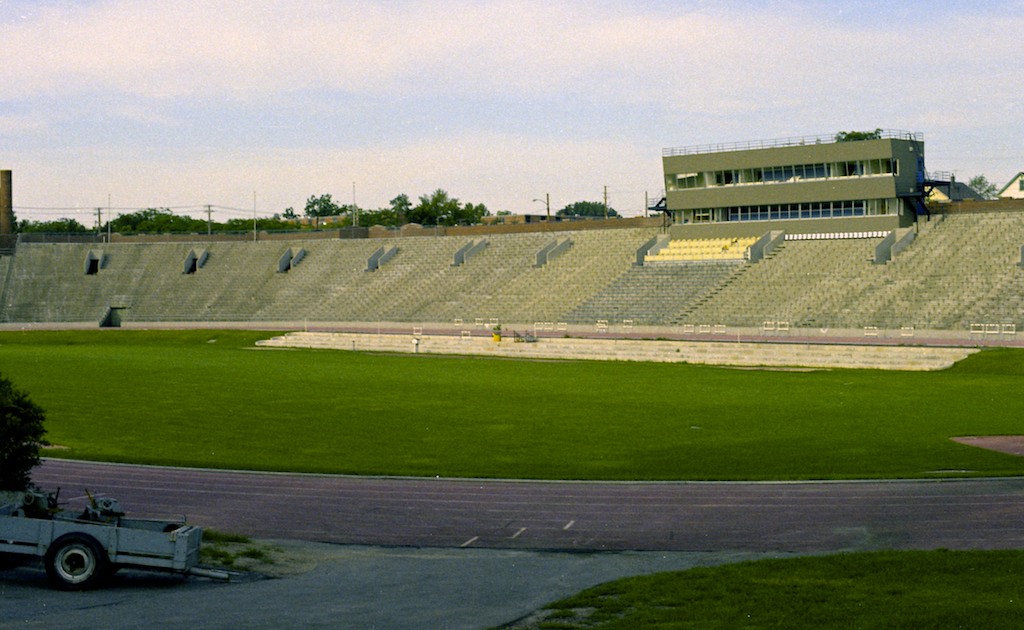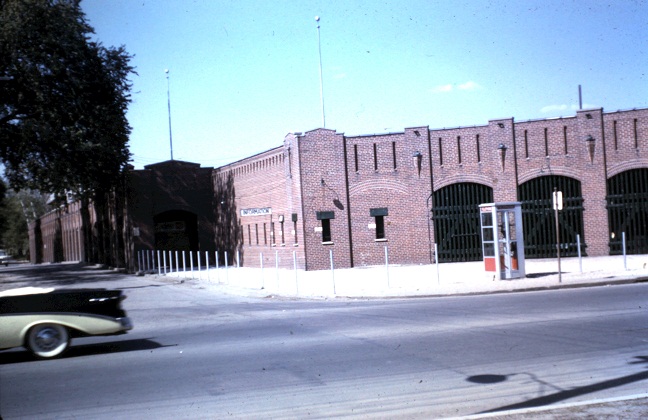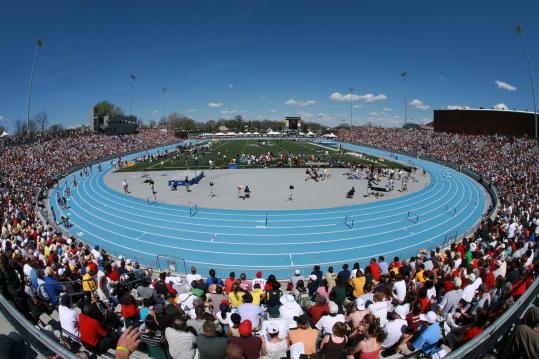Difference between revisions of "Drake Stadium"
| Line 5: | Line 5: | ||
| − | [[File:Drake_Stadium1.jpg| | + | [[File:Drake_Stadium1.jpg|400px|left|frame|Drake Stadium Overhead View - Times Delphic 1964]] |
| Line 12: | Line 12: | ||
| − | [[File:Stadium.1973.LEESON.jpg| | + | [[File:Stadium.1973.LEESON.jpg|400px|left|frame|Photo of Drake Stadium taken cerca 1973s, contributed by Mr. Phil Leeson AS'76]] |
| − | [[File:Stadium.REA.jpg| | + | [[File:Stadium.REA.jpg|362px|right|frame|Drake Stadium - photo by Clifford Rea, AS'60]] |
| − | [[File:Stadium.REA2.jpg| | + | [[File:Stadium.REA2.jpg|439px|left|frame|Drake Stadium - photo by Clifford Rea, AS'60]] |
==Structure== | ==Structure== | ||
| − | [[File:Drakestadium_bleachers.JPG| | + | [[File:Drakestadium_bleachers.JPG|320px|right|frame|Drake Stadium Bleachers- Photo taken by Alyson Collins 2010]] |
Right away, civil engineers shot down the idea of turning Haskins's property into a stadium because of the hilly terrain in the area. These engineers were proven wrong. The outside structure itself is located on what used to be a ravine. Because of this, the field was beneath ground level and the bleachers extended up onto the sides of the hills.[1] After spending thousands of dollars to remove part of the hills, a quarter mile track was dug out. Since the track was first constructed, it has undergone major transformations. It started as black cinders, was changed to red brick, then to red tartan, and is now Drake Blue tartan.[4] A new surface was added to the track in the 2005 renovation. The original seating capacity of the stadium in 1904 was 2,500[2] but numerous renovations have increased the current seating capacity to 14,557.[5] | Right away, civil engineers shot down the idea of turning Haskins's property into a stadium because of the hilly terrain in the area. These engineers were proven wrong. The outside structure itself is located on what used to be a ravine. Because of this, the field was beneath ground level and the bleachers extended up onto the sides of the hills.[1] After spending thousands of dollars to remove part of the hills, a quarter mile track was dug out. Since the track was first constructed, it has undergone major transformations. It started as black cinders, was changed to red brick, then to red tartan, and is now Drake Blue tartan.[4] A new surface was added to the track in the 2005 renovation. The original seating capacity of the stadium in 1904 was 2,500[2] but numerous renovations have increased the current seating capacity to 14,557.[5] | ||
| − | [[File:drake_relays.jpg| | + | [[File:drake_relays.jpg|379px|left|frame|Crowd during the Drake Relays - Photo from www.gobulldogs.com]] |
==Drake Relays== | ==Drake Relays== | ||
| Line 28: | Line 28: | ||
| − | [[File:drake_stadium_map_edit.jpg| | + | [[File:drake_stadium_map_edit.jpg|290px|right|frame|Taken from Google Maps - Drake Stadium is at top center]] |
==Location== | ==Location== | ||
| Line 39: | Line 39: | ||
| − | [[File:drake_football_game.jpg| | + | [[File:drake_football_game.jpg|320px|left|frame|Drake Bulldogs Football Game - Photo from www.godrakebulldogs.com]] |
| − | [[File:drake_stadium_field_view.jpg| | + | [[File:drake_stadium_field_view.jpg|325px|left|frame|Drake Stadium Field - Photo from www.godrakebulldogs.com]] |
==References== | ==References== | ||
Latest revision as of 15:22, 29 May 2018
Drake Stadium (built 1904, renovated 2005)
Originally submitted by Alyson Collins, Drake University, December 3, 2010
The Drake Stadium has been an important part of the athletic history here at Drake University for over one hundred years now. The stadium is home to numerous events, ranging from athletics to entertainment; years of history are held within this impressive venue. From high school football games to the world famous Drake Relays, the Drake Stadium plays an important role in the Des Moines community, and especially in Drake Athletics.
History
Officially dedicated on October 8,1904, before Drake faced off with University of Iowa in football, the stadium was originally named Haskins Field. Norman Haskins not only donated the land to the university to become a stadium, but also a significant amount of funds to build the stadium as well.[1] In the beginning, the field was named Haskins Field in honor of the donor's son, Alvan A. Haskins.[2] Alavan was a Drake alumnus who passed away in 1896. Later, in 1909, Norman Haskins requested the name of the field be changed to Drake Stadium. It was noted though that the stadium was "A Gift of Norman Haskins to Drake University". In the years of remodeling that followed, this recognition of the stadium's generous donor was removed.[3]
Structure
Right away, civil engineers shot down the idea of turning Haskins's property into a stadium because of the hilly terrain in the area. These engineers were proven wrong. The outside structure itself is located on what used to be a ravine. Because of this, the field was beneath ground level and the bleachers extended up onto the sides of the hills.[1] After spending thousands of dollars to remove part of the hills, a quarter mile track was dug out. Since the track was first constructed, it has undergone major transformations. It started as black cinders, was changed to red brick, then to red tartan, and is now Drake Blue tartan.[4] A new surface was added to the track in the 2005 renovation. The original seating capacity of the stadium in 1904 was 2,500[2] but numerous renovations have increased the current seating capacity to 14,557.[5]
Drake Relays
Probably the most significant event that occurs at Drake Stadium is the annual Drake Relays. This world famous event began in 1910 and is held during the last weekend in April each year. Some esteemed runners that have participated in the relays include Jesse Owens, who in 1935, won the 100-yard dash and set an American record in long jump, and Wilma Rudolph in 1961.[4] Every year, the stadium is full to capacity with crowds cheering on track stars from throughout the country, as long as it doesn't rain or snow. In 1957, the Drake Relays became the first sporting event televised on ABC's Wide World of Sports, making the famous Drake Relays even better known.[4]
Location
Drake Stadium is located at 2719 Forest Avenue.
The stadium is located conveniently across Forest Avenue from the university and across 27th Street from the Bell Center, another one of Drake's athletic facilities.
Drake Stadium Today
In 2005, Drake Stadium underwent its most recent and most dramatic renovation since its last major remodeling in 1925. The $15 million transformation included changing the field to turf, widening of lanes, a video scoreboard, and improvements to the restrooms, seating, concessions, and press box. After the most current renovations, the field was named Johnny Bright] Field in honor of the Drake alum and football player of the 1940s and 50s. The Jim Duncan Track is named for the well-known Drake Relays announcer. Today the field sees even more use outside of Drake athletics. Some of the events that have been held in the twenty first century include NCAA Midwest Regional Track and Field Championships in 2007 and in 2008, the NCAA Outdoor Championships. To this day, Drake Stadium is still considered one of the premier track and field facilities in the country.[5]
References
- [1] Carpenter, M.A. (1904, October). Opening of year 1904-5: the Drake Stadium. Drake University Record//, //1(6), 2-4.
- [2] Larson, L. (1964, October 28). Drake Stadium has colorful history. Times Delphic.
- [3] Drake Stadium deep in history, tradition. (1966, September 30). Times Delphic.
- [4] Morrison, P. Recollections of Drake Stadium. Drake Relays: America's Athletic Classic, 26-27.
- [5] The world's best perform at historic Drake Stadium [Web Entry]. Retrieved from http://www.godrakebulldogs.com/ViewArticle.dbml?SPSID=82259&SPID=8137&DB_OEM_ID=15700&ATCLID=899758&ATCLPID=1&SENDING_AS_EMAIL=&PRINTABLE_PAGE=








